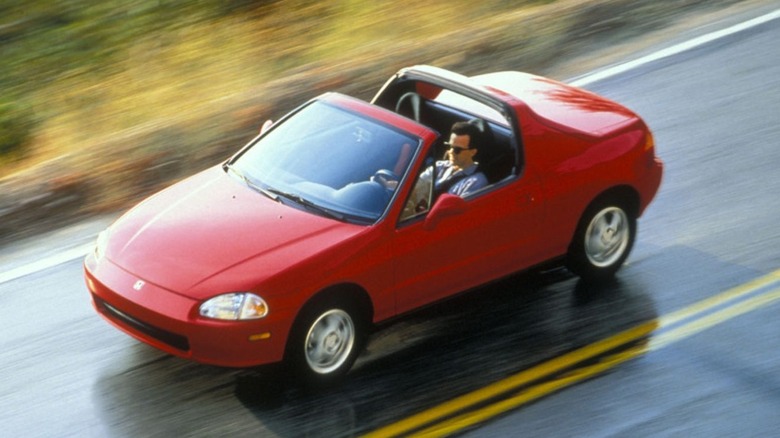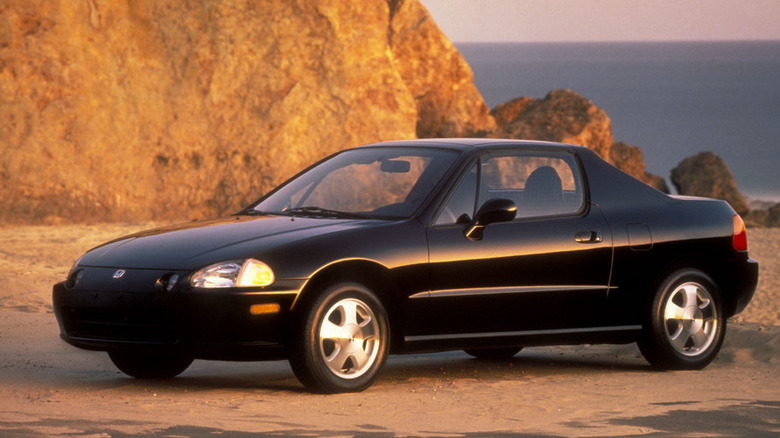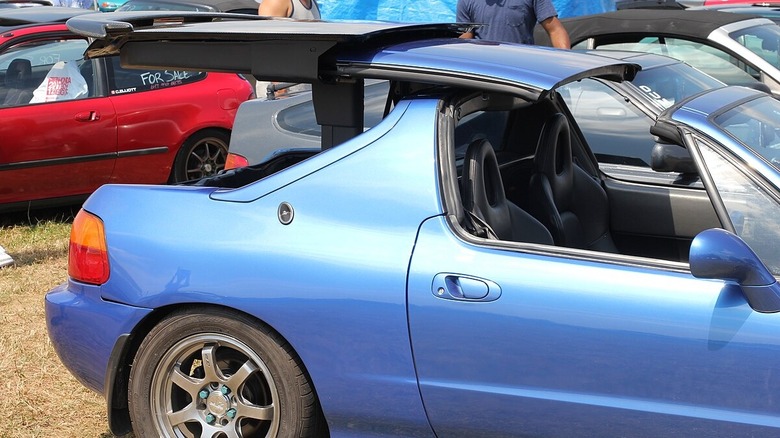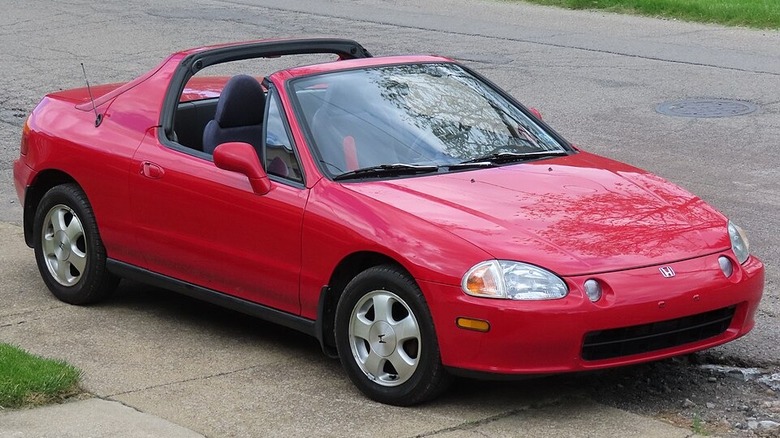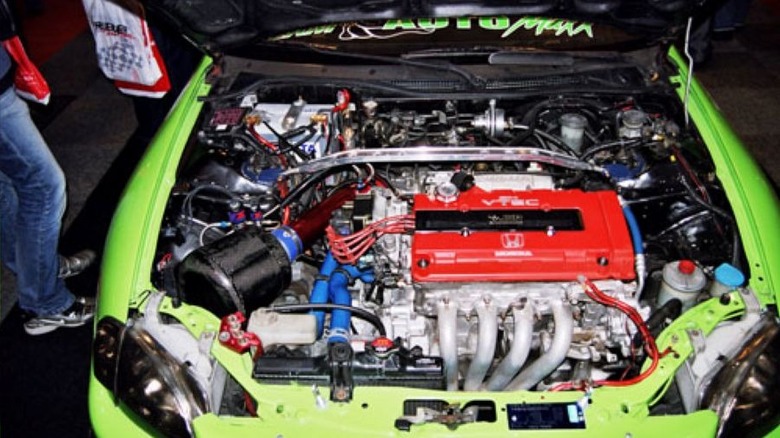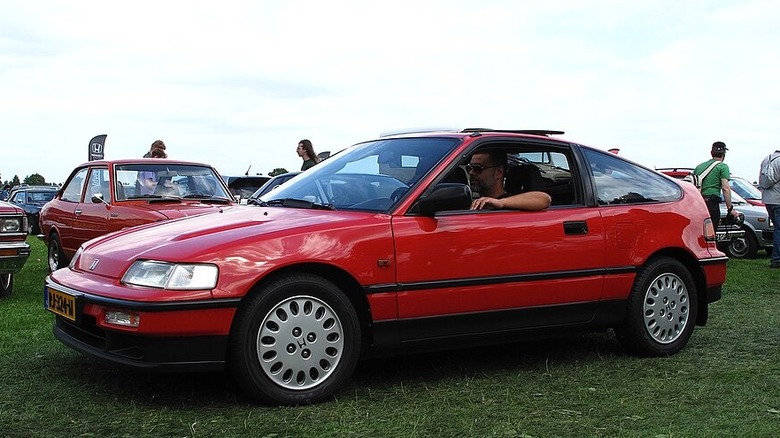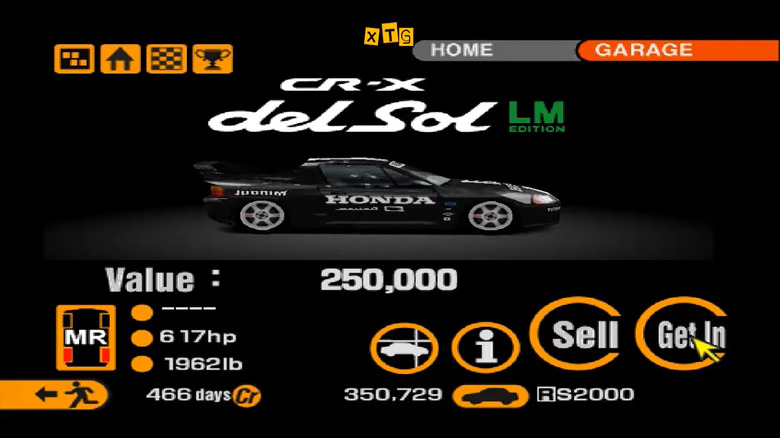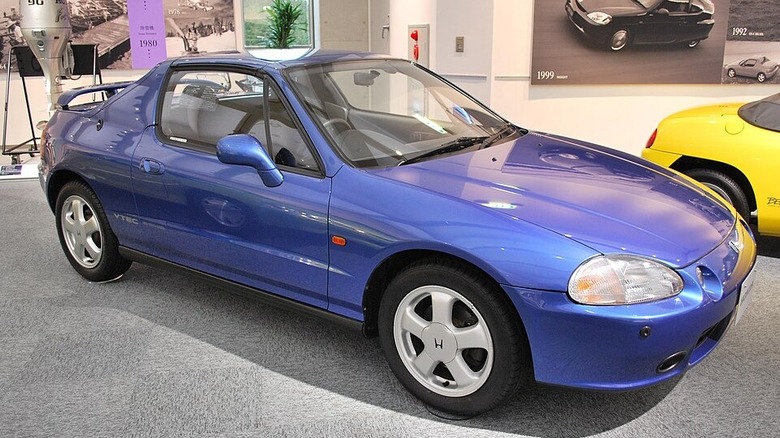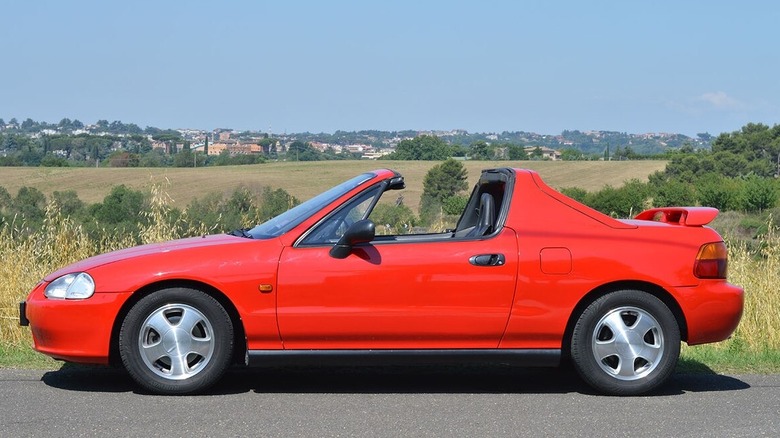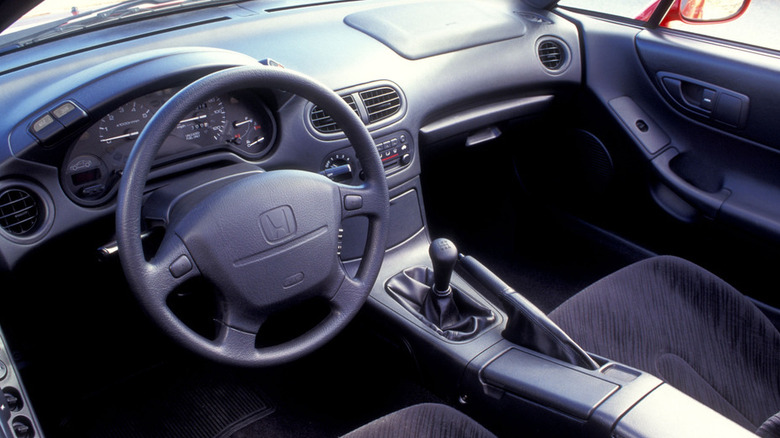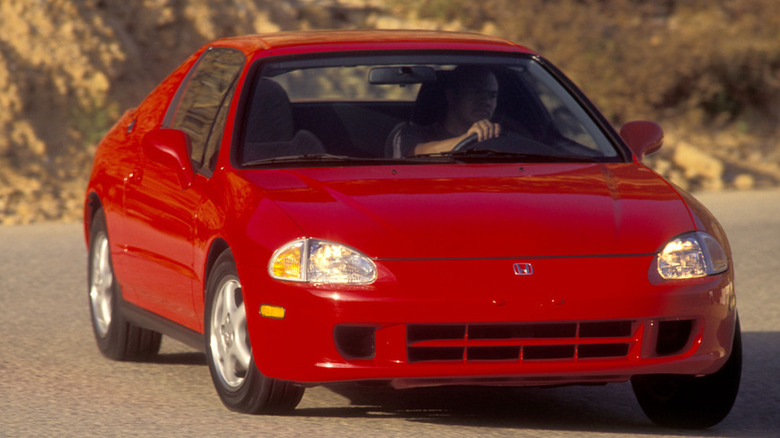13 Things To Consider Before Buying A Used Honda Del Sol
A few dedicated two-seat sports cars litter the landscape of Honda's years of auto production. There's the decade-long run of the Honda S2000, spanning 1999 to 2009. The Honda/Acura NSX competed with supercars during its 14-year production between 1991 and 2005. At the other end of the budget, the Honda CRX was a peppy, short-wheelbase roadster with just enough room for you and your sweetie. The market for affordable, sporty two-seaters has dwindled. The BRZs, GR86, and MX-5s of the world still represent the niche, but reaching back a decade or two can be a prime way to score some two-seat zip, be it for track weekends or daily driving.
The Honda Del Sol hit the market as a 1993 model. With low displacement and a few Honda performance tricks, the quirky coupe was moddable and accessible, giving fans of buzzy Japanese imports something to chew on while waiting for "The Fast and the Furious" to drop.
This car hasn't been enshrined in the pantheon of automotive greats alongside the NSX, nor has it earned the cache of the S600, let alone the S2000. Yet the forgotten targa represents a dwindling market. If an affordable two-seater with upside is on the menu for your next car purchase, here are 13 things to consider before buying a used Honda Del Sol.
The vehicle is not spacious
Even a quick look at the Del Sol reveals a glaring potential deal-breaker. It is not large. In fact, it is downright small. Offensive linemen, volleyball middle blockers, and basketball centers may want to have a peek around the specs page of the Del Sol's dimensions before getting serious about owning one.
The inaugural 1993 model carried an overall length of 157.3 inches, height of 49.4 inches, and width (without mirrors) of 66.7 inches. Headroom was 37.5 inches, legs could stretch up to 40.3 inches, shoulder room was 52.9 inches, and there were 49.3 inches of hip room. When it went out in 1997, it had gained a whopping four-tenths of an inch in length and retained identical width, head, leg, shoulder, and hip space measurements.
Fitting into a car like the Del Sol, which is light, nimble, and compact, is not for everyone. It's similar to when height restrictions prevent pilots from serving in a compact cockpit. It can be a car drivers wear as much as they pilot, and the claustrophobic may want to think twice.
Every Del Sol had a targa top
The word targa evokes vintage Porsche 911s and Ferrari 308s speeding through winding mountain roads or cruising Ocean Drive. The Del Sol may not come remotely close to keeping up with those cars, but it does provide the iconic targa top experience.
Porsche adopted the targa concept in the 1960s. A roof tying everything together enhances rigidity, which improves performance and efficiency, and that's before you even get to safety. The targa forestalled a potential ban on convertibles by providing the best (and worst) of both worlds. The freedom and sensations of roofless driving lived on, and so did wind buffeting, noisy drives, dismal storage with the top stowed, and the potential to leak.
Some Japanese domestic market (JDM) Del Sol models had an automatic targa, which functioned similarly to a modern convertible hardtop. In place of the trunk, an arm lifted a module for the hardtop to slide into before lowering it into the trunk space, eliminating any chance of hauling even a single bag of groceries with your new daily driver. While not the most practical design, the so-called TransTop came on a special Del Sol, which also packed extra horsepower.
The targa was easily one of the coolest features of the Honda Del Sol. It brought the charm of open-air driving to the masses in an affordable package. Aging two-seater targa imports are a niche market, but if you happen to be in it, the Del Sol is an option.
They weren't powerful, but they were fun
The factory Del Sol was a front-wheel-drive vehicle weighing between 2,200 and 2,600 pounds. With a small range of low-displacement engines, the Del Sol is a lesser-remembered performance Honda. No Del Sol ever came with the K-Series engine, but the performance VTI-equipped made as much as 160 hp (170 abroad — harrumph) and 111 lb-ft of torque. The 'VTI' indicates Variable Valve Timing, also known as Honda's vaunted VTEC technology. Introduced in the 1989 NSX, VTEC trickled down to Honda's everyman street performance variants. The Accord Type R still uses it to this day, and Civic Si owners have also enjoyed the tech.
White knuckling the steering wheel of a Z06 as your life flashes before your eyes is excellent fun, but the Del Sol provides something far more enjoyable in the long term: usability. Its power ratings raise no eyebrows today, nor did they upon its release, but the car is fun where it counts most: between 30 and 80 mph. Winding a little Honda up and down your favorite scenic routes is cheaper and safer than a superpowered sportscar, too.
One generation, three models
Between 1992 and 1997, Honda manufactured and sold a limited number of models and trims with subtle differences. The S, Si, and VTEC nomenclature will be familiar to Honda fans. With only five model years comprising a single generation, upgrading the Del Sol was more of a "Ship of Theseus" than a "back to the drawing board" process.
The 1995 Del Sol's base S trim included a 1.5-liter four-cylinder making 102 horsepower and 98 lb-ft of torque. The 1995 Del Sol Si brought that up to 125 hp, accompanied by an increase in torque to 106 lb-ft. The S and Si models offered a choice of a manual five-speed or automatic four-speed transmission, while the VTEC model was exclusively manual. The top-of-the-line Del Sol VTEC boosted horsepower to 160 and tweaked torque to 111 lb-ft, which, when added to a 93.3-inch wheelbase, equals a spirited driving profile.
Leather seats, cruise control, and alloy wheels were available, but only with the Si or VTEC trims, which required an upgrade to access these options at a premium. With such a short lifespan, the Del Sol didn't change all that much, but there were subtle differences.
It is a dream platform for the right tuner
If you headed into this article with the hope of discovering your sleeper roadster, only to feel dismay at the power numbers, we understand. The Del Sol is from another era. Yet there is good news: It makes an excellent platform for performance upgrades, and the aftermarket is rife with options. On a car as light as this, small changes in horsepower and weight reduction yield significant performance gains — and even insignificant ones translate to modified driving feel.
Thanks to its many similarities with other models, including aspects of the Honda Civic and CRX, the Del Sol is a versatile platform. The aftermarket is brimming with upgrade options, making a base Del Sol the perfect starting point for weekend tinkerers and hobbyist racers to begin crafting their own machine.
Options for aftermarket upgrades include the usual suspects, such as air intakes, enhanced braking components, springs and other suspension parts, and turbocharging kits. There's no room to drop a V8 under the hood, but the wrecking yard population of junked Hondas has plenty of old engines for interesting swaps.
Pricing for the Del Sol
Dismally quaint by today's massive price standards, the top-tier Del Sol VTEC model commanded $19,995, the mid-level Si $17,695, and the base S model $15,475. If those numbers sound low, wait until you hear the values today. Classic.com illuminates the state of the secondary Del Sol market, reporting $5,200 low, $10,700 average, and $21,000 top prices based on the website's sales count of 67 cars. A trip to KBB reveals the latest and greatest 1997 Del Sol demanding around $3,300 for the S, $3,700 for the Si, and $4.800 for the VTEC as a fair purchase price.
A peek at the live market reveals a dearth of Del Sols for sale. A nationwide search for used Del Sol vehicles of any mileage, trim, and transmission reveals six available on Autotrader and four on Cars.com. Between those two sites, the asking price (not the agreed price, which is very different), ranged from $3,500 to over $24,000. Top sale outliers notwithstanding, finding used Del Sols out there for under $10,000 is possible.
The Del Sol is one of three siblings
In the time of the formless yet functional crossover SUV and the U.S. government encouraging enormous pickup trucks, it's hard to imagine a world in which an automaker offered overlapping two-seater budget sports cars in the same markets at similar prices. Yet that's precisely what Honda did.
By the 1980s, Honda had become firmly entrenched in North America, and the Civic had been on the streets for nearly a decade. Honda aimed to encourage the evolution of the Civic while recapturing some of the sports car credibility it had once garnered with the Honda S500 and S600. Clever organization combined and streamlined these objectives by developing a Civic-based platform from which three vehicles emerged, two of them exclusively two-seaters.
From the Civic sprang the Honda Civic CRX Del Sol, sometimes known as any of the three in some markets. The CRX had debuted in 1983 as a hardtop hot hatch. In 1993, targa fans finally got their wish with the 1993 Del Sol.
It sips gasoline
Hybrids and EVs are all the rage, but there's still something to be said for a well-designed internal combustion engine built to perform on fumes. Honda sold its first car in the United States, the teensy-tiny, cutesy-wutsey N600, in 1969. Yes, the same year Chevrolet put out the Chevelle SS with a 427 V8 engine, and only a year or two before the high-water mark of muscle mania.
As the oil and gasoline crises decimated the demand for muscle cars, Honda became a byword for efficiency, and the Del Sol carried on that tradition. The difference in EPA mileage between models is as minuscule as the displacement. The 1993 1.5-liter automatic achieved 26 mpg city driving, 33 mpg highway, and 28 mpg combined. The 1.5-liter manual and 1.6-liter automatic and manual transmission all come within 3 mpg of those numbers across the board.
By the end of the run in 1997, gas efficiency was much the same, with an average of 25 mpg city, 32 highway mpg, and 28 combined mpg. The efficiency winner for 1997 was the manual 1.6-liter with 28/35/31 combined mileage. With a fuel tank of 11.9 gallons, the Del Sol also has the range to make an efficient daily driver.
The Del Sol is the star of Gran Turismo, sort of
The "Gran Turismo" series has been the darling of PlayStation car enthusiasts since the days of the first generation of Sony's game console. It allows gamers to start as a humble racer and decide their preferred method for upgrading, updating, and racing simulated race cars.
One of these humble beginnings included the Honda CR-X del Sol SiR. Players could doll it up with Vogue Silver Metallic, Flint Black Metallic, Milano Red, Samba Green Pearl, or Captivate Blue Pearl paint before taking it to racetracks at worldwide events. The Del Sol also shows up as an unplayable vehicle in certain cutscenes throughout the series.
The Del Sol disappeared from "Gran Turismo" after the 6th iteration, but remains in the hearts of those who blistered thumbs and wore down PlayStation controllers heel-toeing the Del Sol around endless laps of the best tracks in the world.
It hides some intriguing engines
Honda's efforts to bolster its sport reputation started gaining traction when its B-series engines debuted in the 1986 Prelude 2.0 Si, Vigor, and Accord. The B16A later made it into the 1989 CRX Si. By the time the Del Sol arrived, the B was a developed engine with a pedigree and a future. Not every Del Sol got one, but certain VTEC models have this gem of an engine hiding under the hood.
Bear in mind that many base Del Sols came equipped with the less desirable, but no less moddable D-series. Between 1993 and 1995, the base S trim delivered a D156B7 1.5-liter engine that made 106 hp and 98 lb-ft of torque. Early Si models received a power upgrade to 125 hp and 106 lb-ft of torque via a D16Z6.
Honda created the B16A3 for the Del Sol. Between 1994 and 1995, the variant produced 160 hp at 7,600 rpm and 111 lb-ft at 6,700 rpm, revving to 8,200 rpm. The B16A2 can be found under the hood of certain 1996-1997 Del Sols. The VTEC engine made 150 hp at 7,600 rpm, 111 lb-ft of torque at 7,100 rpm, and revved to the same 8,200 rpm redline as the A3.
Whether B-Series or D-Series, these little engines are slowly becoming relics of a certain era of internal combustion. There will be a place at future car shows for unusual tuners from the mid-'90s. In the meantime, aspiring gearheads and seasoned mechanics alike have an enormous selection of performance and cosmetic aftermarket parts to play with.
Performance and cosmetic aftermarket parts are abundant
The B-Series has a bit of name recognition, but you can live your own "Gran Turismo" fantasy with D-equipped Del Sols. One search at Speed Factory Racing revealed over 150 parts ranging from engine internals to camber kits — and that was for the lowly D156B7.
Entire companies are built around supplying parts and upgrades for the B-Series and the D-Series. Fishing a dilapidated Del Sol with your favorite engine out of a junkyard is still possible, though it may not always be. You could virtually build a B-engine from the ground up from aftermarket parts, giving you the chance to live fast and furious fantasies with a dose of NOS or several pounds of boost. The options for cosmetics, handling, interior, and other aspects of performance are no less deep. Honda's aftermarket ecosystem is incredible. Finding advice and parts online and in person should be no problem. You may even make some new friends.
Del Sol ownership is a community
People love these cars. The Del Sol was one flash in a pan filled with many brighter flashes, yet its fanbase remains vibrant. Dozens of communities litter social media, and Del Sols are sure to start conversations at car shows and cars-and-coffee gatherings.
The short active career of the Del Sol puts it in an interesting position 30 years down the line. They were unique and quirky in a market crowded with both. True sports cars — only two seats — Del Sols won't go down in the racing halls of fame. They emerged from the same incestuous primordial stew as the CRX and the Civic, but with a distinct personality. We can't say for sure, but we imagine Del Sol drivers give the recognition wave when they see one another, a la motorcyclists and Corvette pilots.
Calling something a future classic is a surefire way to be dead wrong most of the time. No one can say the remaining Del Sols won't continue down the valuation ladder into oblivion. There's no shame in it. It happens to all but the legends. Yet if you made it this far into the article and are impressed with the Del Sol's character, you may be ready to join this vibrant community yourself.
Production numbers
When the 1993 Del Sol sold 25,000 models the first year, it looked like the beginning of a modest success. Unfortunately, like many before it, its first year proved to be the most successful. The Del Sol's sophomore production shrank to around 21,000, and the remaining model years fell off a cliff, with 14,021 built in 1995, 8,489 in 1996, and 5,603 in 1997.
With a total of around 75,000 built, the Del Sol isn't quite rare, but it's not exactly common, either. Another two-door targa sports car, albeit in a different class, the Corvette, sold an estimated 100,000 in a similar time frame. That 25% difference echoes down the years. If half of the Del Sols ever made have been destroyed or otherwise lost, that's not many cars left. The fact that the Del Sol didn't have an epic Corvette-esque production run may mean there are fewer samples, but it does not make them any less niche.
It is not a grand touring vehicle
The dedicated mechanic may be able to make the Del Sol into a road trip dream, but that's not really the point. The tiny targa was made for moonlight blasts to the beach, sweaty days at SCCA meets, and autumn mornings at cars and coffee. It isn't smooth or quiet. The targa can leak wind and water. It can feel cramped inside. Driving on the double date is out of the question. All of which brings us to our final point, which was also our first one.
The Honda Del Sol is not for everyone. Yet, these days it is not easy to find a classic sports car that won't annihilate the wallet. And this is nothing if not a neon-bright mid-90s vibe, an era people seem wistful about. It was from a period a generation ago, and it is only beginning to explore a potential legacy.
